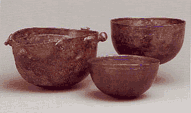BurialsX-GroupThe end of the Meroitic period was not spontaneous, it was rather gradual and is most evident in the shift of building materials from more durable to more perishable ones.
The post-Meroitic period, which starts approximately after 350 CE, is distinguished by the emergence of a new culture in Sudan labeled as the X-Group; the culture is associated with the Nobatian nomadic tribes who migrated from the deserts neighboring the Nile Valley. The X-Group culture shares alot with the older Kerma culture of Kush. This is most evident in burial traditions where X-Group rulers were buried in tumuli structures, just like the rulers of Kerma in the past. In Ballana and Qustol, in Lower Nubia, and at el-Hobagi, Jebel Adda, Jebel Quisi, and Meroe, in Sudan, X-Group tumuli were located in large numbers; however, most of those in Sudan have not yet been excavated. The sizes of the tumuli varies to a great degree. In Ballana the largest of the tumuli measured 77 feet in diameter and 12 meters high.1
Niche cut pits represented the common form of burials among the local population . Although in many burials the deceased were buried in the extended body position, the X-Group largely favored a contracted position. The funerary goods also continued to accompany tombs, though not as luxurious and elaborate as the royal burials in the Meroitic period. The tradition of mummification continued among the high-class members of the population. Most funerary goods included unique pottery usually polished red and with distinctively little designs. However many pots were designed in a style closely related to the Kushite-Napatan and Roman styles of art. Other metal and bronze weapons like spears and arrows were also found. Human sacrifices were especially abundant in X-Group tumuli. Animal sacrifices were also found and has included dogs, camels, and horses. With the Christianization of Nubia in the sixth century, human and animal sacrifices largely disappeared and burials were usually done in simple pits.
Edited: Jan. 2009. |

